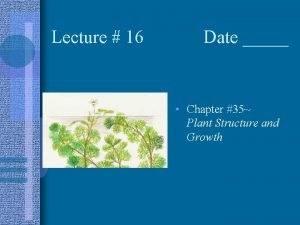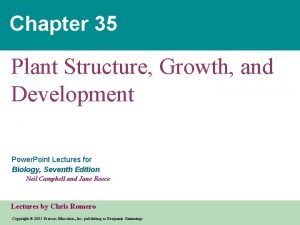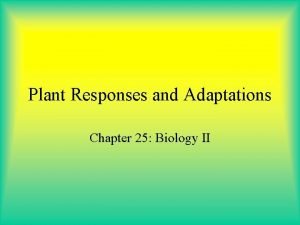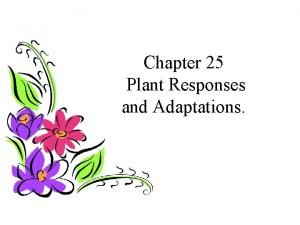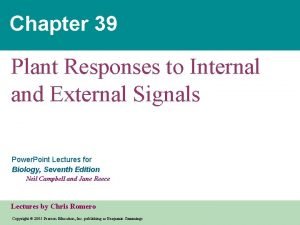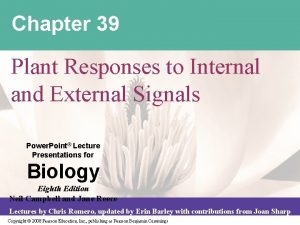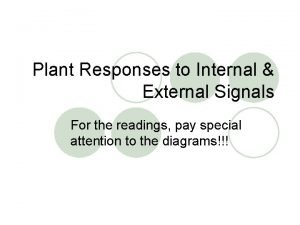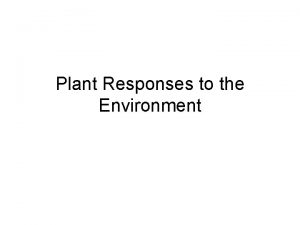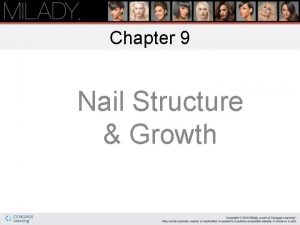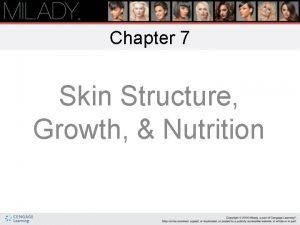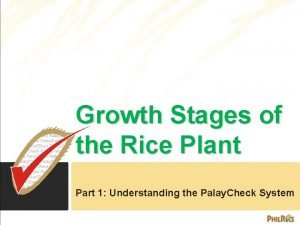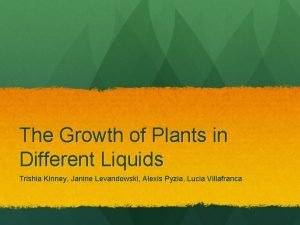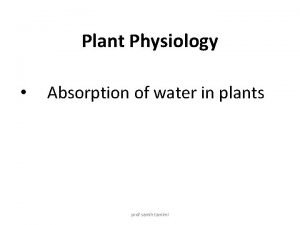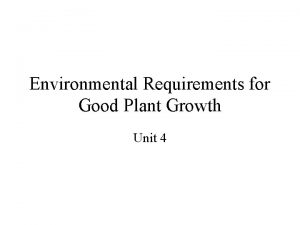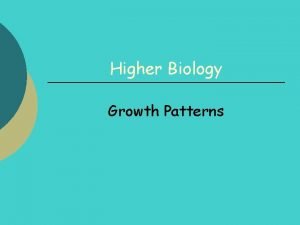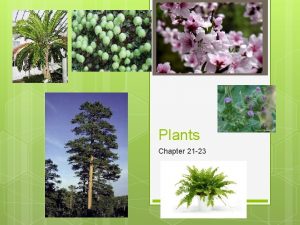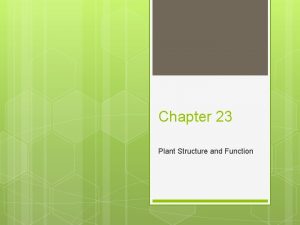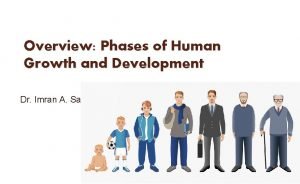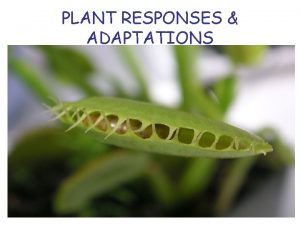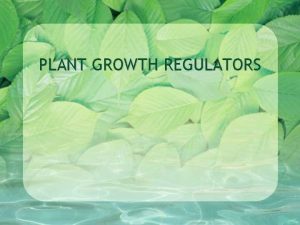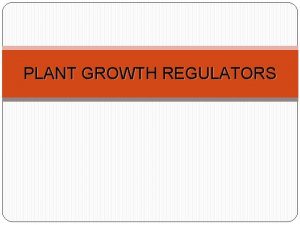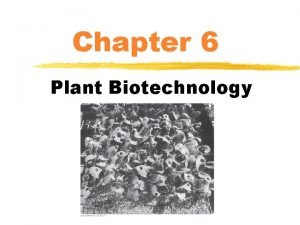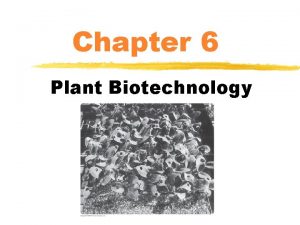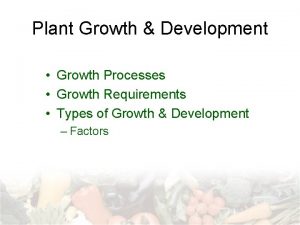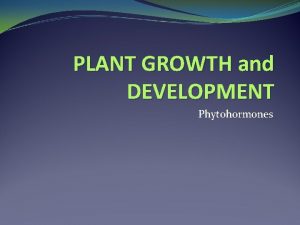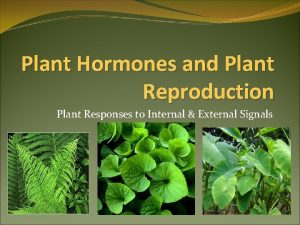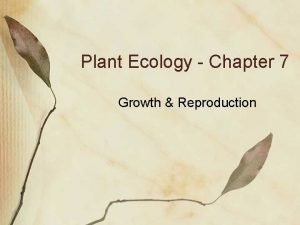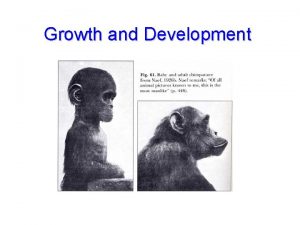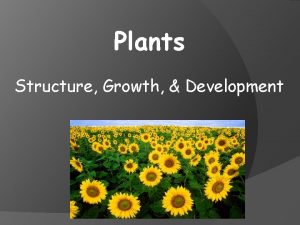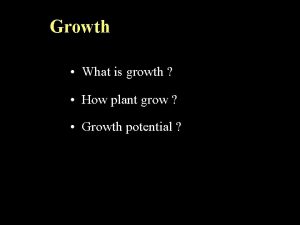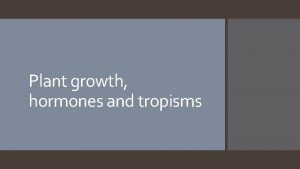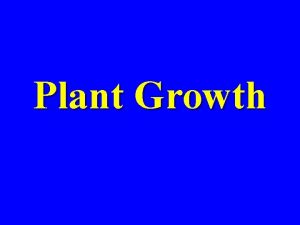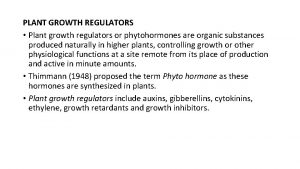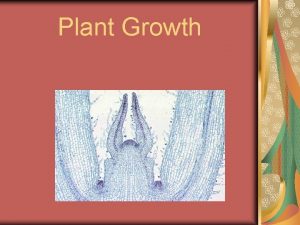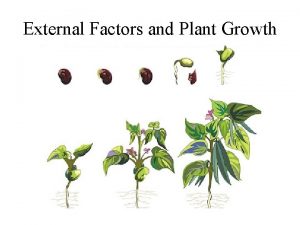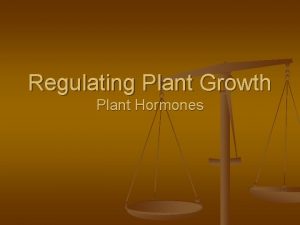Plant Structure Growth Development Chapter 35 Plant Responses



































- Slides: 35

Plant Structure, Growth & Development Chapter 35 _______ Plant Responses Chapter 39

Chapter 35

Hierarchical Organization in Plants Three basic plant organs: 1. Roots 2. Stems 3. Leaves

Roots Anchors vascular plant in soil Absorbs minerals and water Stores carbohydrates Root Parts: • Taproot – main vertical root of eudicots and gymnosperms, develops from embryonic root • Lateral roots – branch from taproot In monocots, embryonic root dies and small roots emerge from stem – fibrous root system


Stems Raise or separate leaves, exposing them to sunlight Also raise reproductive structures to facilitate pollen dispersal Alternating system of: • Nodes – point where leaves are attached • Internodes – stem segments between nodes Most of the growth of a young plant is in the apical (terminal) bud Leaves emerge at the axillary bud


Leaves Main photosynthetic organ in vascular plants Consist of: • Blade – generally flat • Petiole – stalk that join blade to stem at node Monocots – parallel veins Eudicots – branching veins Simple vs Compound leaves: • Simple- single, undivided blade • Compound – blade consists of multiple leaflets • Doubly compound – each leaflet is divided into smaller leaves


Evolutionary Adaptations of Leaves Tendrils – “lassoes” something to provide more support for the stem Spines – protection, do not photosynthesize Storage leaves – succulents Reproductive leaves – make plantlets that fall off and take root in soil Bracts – often mistaken for petals; surround a group of smaller flowers and attract pollinators

Tendrils Spines Storage Reproductive Bracts

Plant Tissues Dermal – plant’s outer, protective covering (epidermis and cuticle) Vascular – carries out long distance transfer of materials between roots and stems (xylem & phloem) Ground – neither dermal nor vascular; performs specialized functions such as storage, photosynthesis & support


Plant Cells Parenchyma – perform most of the metabolic functions of plant Collenchyma – flexible, support young parts of plant shoot Sclerenchyma – rigid support for mature plants, especially trees


Plant Cells, cont. Water conducting cells in Xylem (dead at functional maturity) • Tracheids • Vessel elements Sugar-conducting cells in Phloem (alive at functional maturity) • Sieve tube elements • Sieve plates • Companion cells


Growth in Plants Unlike animals, plant growth is not limited to an embryonic and juvenile period Indeterminate growth – at any time the plant as a whole has embryonic, developing and maturing organs Leaves, thorns and flowers undergo determinate growth

Growth in Plants, cont. Meristems - specific regions of growth • Contain stem cells: perpetually embryonic tissue • regenerate new cells Apical shoot & root meristem o Provide growth in length o primary growth Lateral meristem o Provide growth in girth o secondary growth

Apical meristems shoot root

Root structure & growth protecting the meristem

Woody stem How old is this tree? cork cambium vascular cambium late early 3 2 1 xylem phloem bark

Chapter 39

Response to Stimuli At the organismal level, plants and animals respond to environmental stimuli by different means Animals, being mobile, respond mainly by moving toward positive stimuli and away from negative stimuli Plants are stationary and generally respond to environmental cues by adjusting their individual patterns of growth and development • For this reason, plants of the same species can have much more variation in body form than animals of the same species

Tropisms Tropism – any growth response that results in plant organs curving toward or away from a stimulus • Phototropism – growth of a shoot toward (positive) or away (negative) from a light source • Photoperiodism – physiological response to a photoperiod (like flowering) • Gravitropism – growth of shoots and roots in response to the pull of gravity • Thigmotropism – directional growth in response to touch

Growth in Plants Etiolation – morphological adaptations for growing in darkness • Pale stems • Rapid stem elongation • Unexpanded leaves • Short, stubby roots • Example – young potato plant in the soil

De-etiolation (greening) • Stem elongation slows • Leaves expand • Roots elongate • Shoot produces chlorophyll • Receptor in cytoplasm called a phytochrome is responsible

Plant Hormones Hormone – signaling molecule that is produced in tiny amounts by one part of an organism’s body and transported to other parts, where it binds to a specific receptor and triggers responses in target cells and tissues (phew!!!!) Plant hormone = plant growth regulator One hormone can regulate a diverse array of cellular and developmental processes Multiple hormones can influence a single process

Plant hormones Auxin Gibberellins Abscisic acid Ethylene and more…

Auxin (IAA) Effects controls cell division & differentiation phototropism • growth towards light • asymmetrical distribution of auxin • cells on darker side elongate faster than cells on brighter side apical dominance

Gibberellins Family of hormones • over 100 different gibberellins identified Effects • stem elongation • fruit growth • seed germination plump grapes in grocery stores have been treated with gibberellin hormones while on the vine

Abscisic acid (ABA) Effects slows growth seed dormancy • high concentrations of abscisic acid • germination only after ABA is inactivated or leeched out • survival value: seed will germinate only under optimal conditions • light, temperature, moisture

Ethylene Hormone gas released by plant cells Effects • fruit ripening • leaf drop o like in Autumn o apoptosis

Fruit ripening Adaptation • hard, tart fruit protects developing seed from herbivores • ripe, sweet, soft fruit attracts animals to disperse seed Mechanism • triggers ripening process o breakdown of cell wall - softening o conversion of starch to sugar - sweetening • positive feedback system o ethylene triggers ripening o ripening stimulates more ethylene production

Apoptosis in plants Many events in plants involve apoptosis • response to hormones o ethylene o auxin • death of annual plant after flowering o senescence • differentiation of xylem vessels o loss of cytoplasm • shedding of autumn leaves What is the evolutionary advantage of loss of leaves in autumn?
 Chapter 35 plant structure growth and development
Chapter 35 plant structure growth and development Primary growth and secondary growth in plants
Primary growth and secondary growth in plants Apical meristem
Apical meristem Chapter 25 plant responses and adaptations
Chapter 25 plant responses and adaptations Positive geotropism
Positive geotropism Seed germination
Seed germination Rice plant morphology
Rice plant morphology Cytokinin function
Cytokinin function Plant hormones and responses
Plant hormones and responses Plant hormones and responses
Plant hormones and responses Plant responses to internal and external signals
Plant responses to internal and external signals The stationary life
The stationary life Chapter 7 human growth and development
Chapter 7 human growth and development Relative growth rate equation
Relative growth rate equation Primary growth and secondary growth in plants
Primary growth and secondary growth in plants Step growth polymerization vs chain growth
Step growth polymerization vs chain growth Primary growth and secondary growth in plants
Primary growth and secondary growth in plants Geometric exponential growth
Geometric exponential growth Neoclassical growth theory vs. endogenous growth theory
Neoclassical growth theory vs. endogenous growth theory Organic vs inorganic growth
Organic vs inorganic growth The dead colorless tissue attached
The dead colorless tissue attached Name the basic parts of the nail unit
Name the basic parts of the nail unit Skin structure growth and nutrition
Skin structure growth and nutrition Chapter 10 stress responses and stress management
Chapter 10 stress responses and stress management Stages of rice plant
Stages of rice plant Plant growth with different liquids
Plant growth with different liquids Significance of transpiration
Significance of transpiration Geotropism
Geotropism Environmental requirements for good plant growth
Environmental requirements for good plant growth What is growth in biology
What is growth in biology Chapter 22 plant structure and function answer key
Chapter 22 plant structure and function answer key Chapter 21 plant structure and function
Chapter 21 plant structure and function Chapter 23 plant structure and function
Chapter 23 plant structure and function Social changes in adulthood
Social changes in adulthood What are the theories of growth and development
What are the theories of growth and development Human growth and development
Human growth and development
